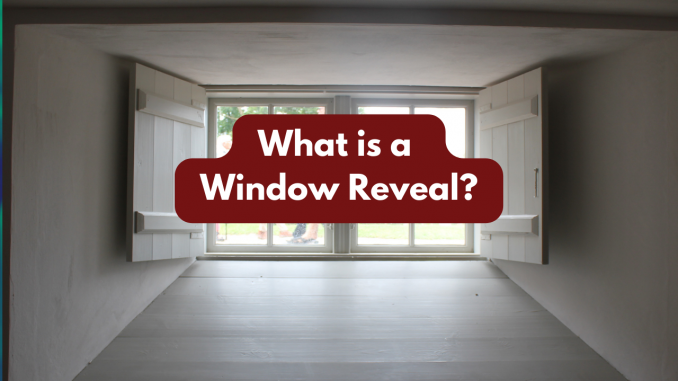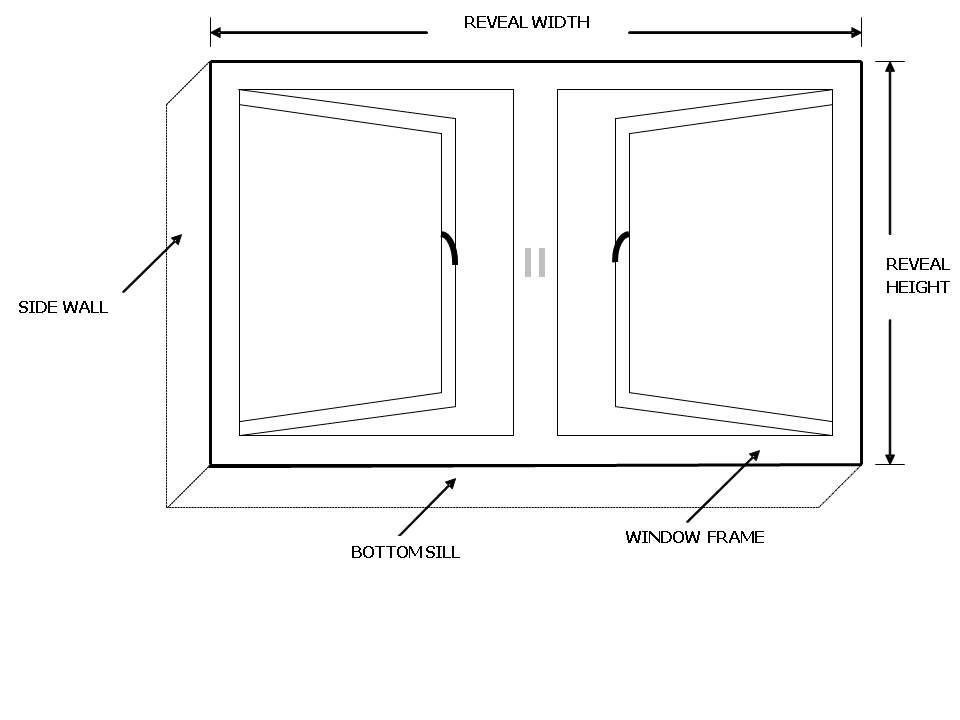
A window reveal is a construction or architectural term that describes the portion of a wall opening that is exposed when a window or door is installed. It is the area between the outer edge of the window or door frame and the adjacent wall surface.
When a window or door is installed, the surrounding wall is usually built to accommodate the dimensions of the frame. The window reveal is the visible part of the wall opening, often finished with materials such as plaster, drywall, or trim, that provide a clean and aesthetically pleasing transition between the window frame and the wall.

The window reveal serves both functional and decorative purposes. Functionally, it helps to protect the window frame from moisture, drafts, and other elements by creating a sealed and weatherproof enclosure. Decoratively, it provides an opportunity to enhance the appearance of the window or door by adding architectural details, such as decorative molding or casing.
The specific design and dimensions of a window reveal may vary depending on the architectural style, construction techniques, and personal preferences. It can significantly impact the overall look and feel of a room or building, contributing to its architectural character.
Popular Window Reveal Types for Your Home in 2024
Window reveals play a crucial role in the design and functionality of homes, with each type catering to specific aesthetic and practical needs. Although bedrooms are not legally required to have a window, it is important to consider ventilation and the types of reveals range from the classic boxed reveal to the modern plaster return, these elements are vital in defining the character and efficiency of window installations. According to many professionals such as EcolineWindows, here’s a breakdown of the most common window reveal types:
Boxed Window Reveal
Encases all four sides of a window with a flat timber surface. It is commonly used with architraves, providing a traditional and versatile look.
No Bottom Reveal (NBR)
It omits the timber reveal at the bottom and is used on the top and sides. This one would be ideal for floor-to-ceiling windows, bathrooms, and kitchens for a seamless transition to other surfaces.
Plaster Return or ‘Square Set’ Reveal
Features plaster extending from the wall to the glass without a visible timber frame. Square set reveal is famous in modern designs for a sleek, tile-adjacent finish, especially in bathrooms and kitchens.
Each type of window reveals offers unique benefits, enhancing the overall design and functionality of window installations in various home settings.
The Dimensions of a Window Reveal
The dimensions of a typical window reveal can vary depending on several factors, including the specific architectural style, building codes, and personal preferences. However, I can provide you with some general guidelines regarding the dimensions of a standard window reveal.
The typical dimensions of a window reveal are measured by Depth x Width x Height
- Depth: The depth of a window reveal refers to the distance between the outer edge of the window frame and the interior wall surface. It is typically in the range of 2 to 4 inches (5 to 10 centimeters). However, this dimension can vary depending on factors such as the thickness of the wall, insulation requirements, and the type of window being installed.
- Width: The width of the window reveal is determined by the overall size of the window frame. It is usually designed to provide a balanced and proportional appearance with the window. For standard residential windows, the width of the reveal can range from a few inches to around 12 inches (8 to 30 centimeters) or more.
- Height: The height of the window reveal is generally determined by the height of the window opening, which is often determined by the floor-to-ceiling height of the room. Similar to the width, it is designed to maintain a proportional look with the window frame and the surrounding wall.
It’s important to note that these dimensions are approximate and can vary based on architectural style, building codes, and individual design choices. Additionally, specific projects may have their own unique requirements, so it’s always recommended to consult with an architect, contractor, or building professional to determine the appropriate dimensions for your specific situation.
Window Reveal Sizes
| Reveal Size | Frame | Interior / Exterior |
|---|---|---|
| 80mm | 70mm steel or timber frame | 70mm stud-gyprock interior weatherboard exterior |
| 100mm | 90mm steel or timber frame | 90mm stud-gyprock interior weatherboard exterior |
| 117mm | 230mm brick veneer | 70mm stud 40mm cavity brick veneer |
| 138mm | 250mm brick veneer | 90mm stud 40mm cavity brick veneer |
| 165mm | 270mm double brick | 50mm cavity brick |
| Storm moulds Double brick lugs | 270mm double brick | 50mm cavity brick |
| Single brick lugs | 110-220mm brickwork | 1110 – single brickwork 220 – pier brickwork- blockwork |
The Difference between Timber Reveal & Brick Reveal
The difference between a timber reveal and a brick reveal lies in the materials used to construct the window reveal.
Timber Reveal
A timber reveal refers to a window reveal that is constructed using timber or wood materials. It involves using wooden frames or casings around the window or door opening. Timber reveals are often used in traditional or classic architectural styles and can provide a warm and natural aesthetic. They can be custom-made to fit the specific dimensions and design requirements of the window.
Brick Reveal
A brick reveal, on the other hand, involves using bricks or masonry materials to create the window reveal. It typically consists of brickwork or masonry construction around the window opening. Brick reveals are commonly seen in buildings with brick exteriors or in masonry-heavy architectural styles. They provide a sturdy and durable appearance and can complement the overall aesthetic of the structure.
While both timber reveals and brick reveals serve similar functions, such as providing a transition between the window frame and the surrounding wall, they differ in terms of material and visual effect. Timber reveals offer a more organic and traditional look, while brick reveals convey a sense of solidity and architectural strength.
The choice between a timber reveal and a brick reveal often depends on the architectural style, design preferences, and the desired visual impact of the building. It’s important to consider factors such as maintenance requirements, compatibility with the overall design scheme, and the climate conditions of the region when selecting between these options.
Overall, window reveals offer both functional and aesthetic advantages for a home. They enhance the architectural design, provide protection and insulation, and allow for customization, ultimately contributing to a comfortable, visually pleasing, and well-integrated living space.


Leave a Reply